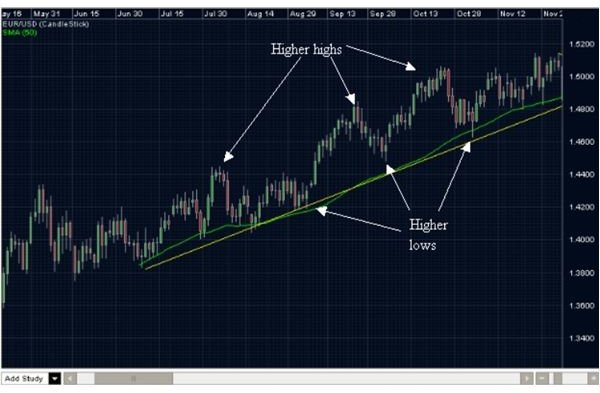What is the Difference Between a Bear and a Bull Market?
Before a trader starts to look for a trading opportunity, he or she must first determine the overall or direct trend of the market. Knowing what is the difference between a bear and a bull market will help traders increase their win/loss ratios and by extension their profitability. What follows are descriptions of the characteristics of bullish and bearish markets.
In a bull market, prices are consistently on the rise, on the back of trader enthusiasm and continuous buying. As a result, prices show no sign of turning around in the short-term. On the other hand, a bear market is one in which there has been a sustained fall in prices, and there is no sign the market will change direction in the near future.
There are quite a few characteristics in bulls and bears, which may explain why these animals are used to represent rising and falling markets. Besides the fact that bears usually attack by grabbing and pulling down their prey and bulls attack by dropping their heads and raking up, the market conditions that they represent can also be seen in the silhouette that is formed by their backs.
The backs of bears gentle slope upward and then fall off from the shoulders onwards. The reverse can be seen in the silhouette of bulls. The bull has a flat back, and a sudden rise from the shoulders onward to the head. Are these striking metaphors for rising and falling markets?
Higher Highs and Lower Lows
Bearish markets are described as constantly making lower lows and lower highs. Even after making a new low, bear markets tend to pullback, or consolidate and then make a new low again. There may be what appears to be a rally, but the market will usually fail to sustain. On the other hand bullish markets have the characteristic of constantly making higher highs and higher lows.
These small pullbacks may show up on the charts as mini bull markets. In another sense, they may be referred to as secondary trends, which may unfold over days or even weeks. When the pullbacks are more rapid and take place over a short timeframe, they are called market corrections.

Another type of market correction is called a bear market rally. Bear market rallies will sometimes trick inexperienced traders because they look so strong and decisive. Hence they are also called a “sucker’s rally.” Normally the market will retrace up to between 20% an 50% of the previous move and then turn and start heading down again. It is very difficult to identify where a bear market will end (or bottom), we can only conclusively say that a bottom has been reached after the fact.
However, markets usually start laying a foundation for a turn when there is a change in the fundamentals. A positive change in the economic data, such as consumer sentiment or retail sales is usually a catalyst for a rally or even a change in the long-term trend.
Market Sentiment
The difference between bear and bull markets can also be seen in terms of trader sentiments. In general, bears are unwilling to buy and bulls are likewise reluctant to sell. As a result, a bull market will continue to rally regardless of whether or not the indicators say the market is overbought and visa versa for bear markets.
Therefore bearish traders may regard every bullish move as a possibly an opportunity to short the market and likewise the bullish traders will jump on most market falls as an opportunity to enter a long trade.
Summary
Sometimes it is obvious that the market is in a perpetual upward motion and in other cases the market may continue to fall. Knowing for sure that you are in a bear or bull market can make all the difference in the world as to how successful your trading. You have a greater chance of success, if you know what is the difference between a bear and a bull market and only buy in a bull market and concentrate on selling in a bear market.
Chart Illustrations provided by the author. All rights reserved.
